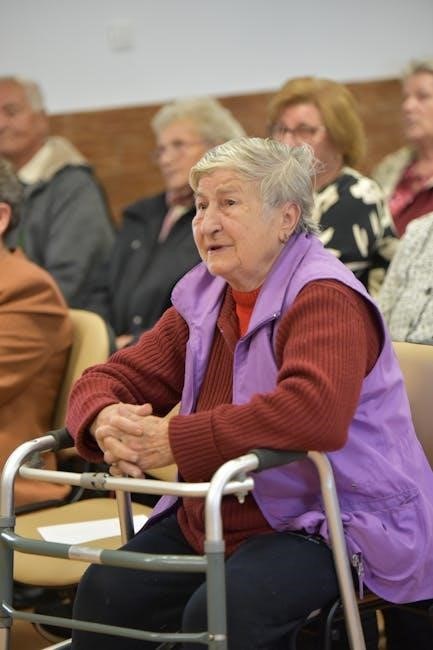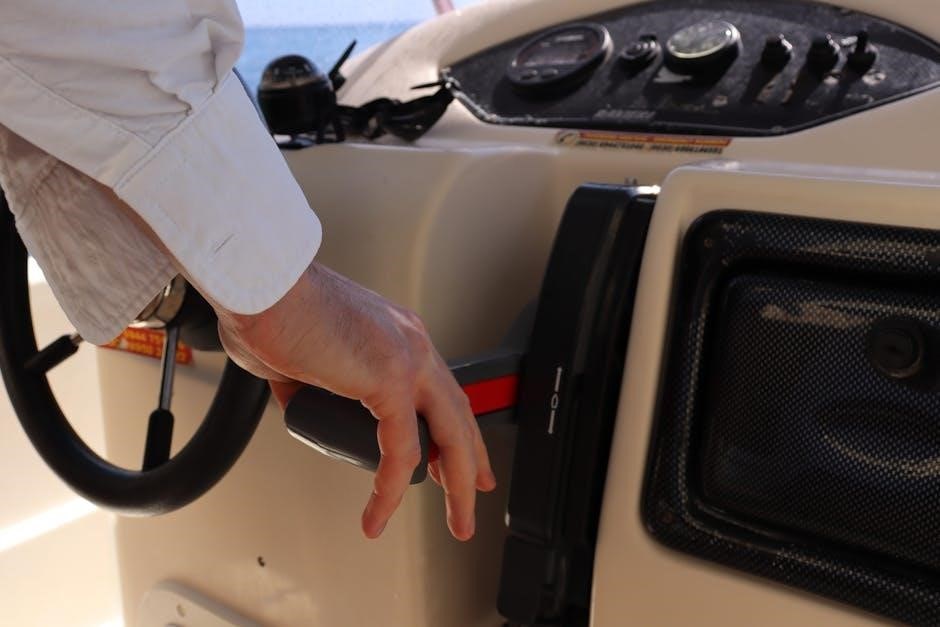The First Aid/CPR/AED Participant’s Manual, published by the American Red Cross, supports training in emergency response skills, covering care for injured or ill individuals and deciding when advanced medical care is needed. It emphasizes critical practices for breathing emergencies, severe bleeding, and injuries, with a detailed reference section for comprehensive understanding.
1.1 Purpose of the Manual
The First Aid/CPR/AED Participant’s Manual is designed to serve as a comprehensive guide for individuals learning life-saving skills. Its purpose is to equip participants with the knowledge and confidence to respond effectively in emergency situations. The manual covers essential techniques, step-by-step procedures, and best practices for providing care. It aims to ensure that learners can apply their skills in real-world scenarios, adhering to established first aid and CPR guidelines. This resource is a vital tool for both training and reference, helping to save lives and improve outcomes in critical moments.
1.2 Target Audience
The manual is intended for individuals seeking to learn or refresh their first aid, CPR, and AED skills. It is ideal for workplace responders, healthcare professionals, educators, and the general public. The content is designed to meet the needs of those requiring certification or recertification, as well as anyone interested in acquiring lifesaving knowledge. The clear, concise format makes it accessible to all skill levels, ensuring everyone can understand and apply the techniques effectively in emergency situations.
1.3 Key Features of the Manual
This manual offers clear, step-by-step instructions for first aid, CPR, and AED techniques. It includes visual aids like diagrams and photos to enhance understanding. Practical scenarios and hands-on exercises are provided to reinforce learning. The content is organized logically, covering emergencies from minor injuries to life-threatening situations. Additional resources, such as quick-reference guides and assessment checklists, are included to support skill retention. The manual is designed to be user-friendly, making it accessible for both new learners and experienced responders seeking refreshers.

Basic First Aid and CPR Concepts
Understanding the chain of survival, universal precautions, and the importance of immediate action form the foundation of effective first aid and CPR responses.
2.1 Understanding Emergency Response
Emergency response involves recognizing and reacting to life-threatening situations effectively. It requires staying calm, assessing the scene, and providing care until professional help arrives. Key components include the chain of survival, which emphasizes prompt action to prevent death or further harm. Understanding universal precautions, such as using gloves and masks, is also critical to protect both the rescuer and the victim. Proper training ensures confident decision-making and timely intervention, which are essential for positive outcomes in emergencies. This foundation builds the skills needed for effective first aid and CPR delivery.
2.2 Recognizing an Emergency
Recognizing an emergency involves quickly identifying signs that someone needs immediate help. Look for loss of consciousness, difficulty breathing, severe injury, or chest pain. Environmental cues, such as a dangerous scene or an unresponsive person, also signal an emergency. Staying calm and acting swiftly is crucial. Assess the situation, provide care if trained, and call for professional assistance when necessary. Prompt recognition ensures timely intervention, improving outcomes in critical situations.
2.3 Emergency Action Steps
When faced with an emergency, follow the priority of Stay Safe, Check, Call, Care. Ensure your own safety first. Check the victim’s responsiveness and airway, breathing, and circulation (ABCs). Call 911 or your local emergency number immediately. Provide care based on training, such as CPR or bleeding control. Use an AED if available and needed. Continue care until professional help arrives. These steps ensure a structured and effective response to emergencies, maximizing the chance of a positive outcome.

Assessing the Situation and Victim
Assessing the situation and victim involves ensuring scene safety, checking responsiveness, and performing primary and secondary assessments to identify injuries or conditions needing immediate attention.
3.1 Scene Safety
Scene safety is crucial before providing care. Always assess the environment for potential hazards, such as falling objects, fire, or unstable structures. Ensure the area is secure to protect both the rescuer and victim. If the scene is unsafe, do not approach until it is made safe. Turn off nearby hazards, such as electricity or gas, if possible. Stay vigilant for moving vehicles or other risks. Prioritize personal safety to effectively assist the victim without putting yourself in danger. Always seek professional help if the scene remains unsafe.
3.2 Primary Assessment
The primary assessment is the initial evaluation of a victim to identify life-threatening conditions. It involves checking the victim’s airway, breathing, and circulation (ABCs). Look for signs of responsiveness, such as movement or verbal response. Check for breathing by observing chest rise and listening for breath sounds. Assess circulation by checking for bleeding or pale, cool skin. This step helps prioritize care and ensures immediate threats to life are addressed first. It is a critical step in providing effective first aid.
3.3 Secondary Assessment
The secondary assessment involves a more detailed evaluation of the victim after addressing immediate life-threatening conditions. This includes a head-to-toe examination to identify injuries or illnesses not apparent during the primary assessment. Check for signs of trauma, swelling, or deformities. Assess vital signs such as pulse, breathing rate, and skin temperature. Gather information about the cause of the emergency and the victim’s medical history. This step helps guide further care and ensures all potential issues are addressed before professional help arrives.

Respiratory and Cardiac Emergencies
This section focuses on life-threatening respiratory and cardiac conditions, such as choking, heart attacks, and cardiac arrests. It provides techniques for relief and interventions to restore normal breathing and circulation, emphasizing the critical role of CPR and AED use in saving lives during these emergencies.
4.1 Choking Relief Techniques
Choking occurs when an object blocks the airway, preventing breathing. Techniques to relieve choking depend on the victim’s age and condition. For adults and children, back blows and abdominal thrusts are effective. Infants require back slaps and chest thrusts. Encourage the victim to cough if they can. If unconscious, begin CPR. Never attempt to remove the object unless visible. Always seek medical help after the incident. Proper training ensures these techniques are performed safely and effectively to restore breathing and prevent complications.
4.2 Cardiopulmonary Resuscitation (CPR)
CPR is a lifesaving technique used when a person’s heart stops beating. It involves chest compressions and rescue breaths to maintain blood circulation and oxygen flow. Start by calling for help and checking the victim’s responsiveness. Place the heel of one hand on the center of their chest, place the other hand on top, and interlock fingers. Perform compressions at 100-120 beats per minute, allowing the chest to fully recoil. Provide rescue breaths if trained. Use an AED if available. Continue until medical professionals arrive.
4.3 Automated External Defibrillator (AED) Use
An AED is a portable device that restores a normal heart rhythm during cardiac arrest. Turn it on and follow voice prompts. Expose the victim’s chest, wipe it dry, and attach pads as shown. Deliver a shock if advised. Do not touch the victim during analysis or shock delivery. Resume CPR after the shock, continuing until emergency services arrive. AEDs are user-friendly and designed for laypersons to operate effectively in emergencies.

Injuries and Wounds
This section covers immediate care for cuts, burns, and fractures. Emphasizes stopping bleeding, cooling burns, and immobilizing injuries to prevent further damage and infection.
5.1 Bleeding Control
Control severe bleeding by applying direct pressure with a clean cloth or gauze. Elevate the injured limb above heart level to reduce blood flow. Use gloves to protect against bodily fluids; If bleeding doesn’t stop, apply a tourniquet between the wound and the heart. Loosen the tourniquet if swelling occurs. Monitor for shock and seek immediate medical help. Avoid removing any embedded objects; stabilize and transport carefully. Proper bleeding control prevents shock and promotes healing.
5.2 Burn Care
For burns, immediately stop the burning process by removing the source of heat. Cool the burn with cool tap water for 10 minutes. Do not use ice or ice water. Remove any clothing or jewelry near the burned area. Cover the burn with a non-stick sterile dressing or clean cloth. Do not apply ointments or break blisters. Monitor for signs of infection, such as redness or swelling. Seek medical attention for severe or large burns. Proper burn care prevents infection and promotes healing.
5.3 Wound Cleaning and Dressing
Clean wounds with cool or lukewarm water and mild soap to remove dirt and bacteria. Avoid using harsh products or scrubbing. Gently pat dry with a clean towel. Apply an antibiotic ointment to reduce infection risk. Cover with a sterile bandage or dressing to protect the wound. Change dressings daily or if soiled. Monitor for signs of infection, such as redness or swelling. Seek medical care for deep or infected wounds. Proper wound cleaning promotes healing and prevents complications.

Sudden Illnesses and Medical Conditions
Recognize and respond to acute medical conditions like heart attacks, strokes, seizures, and allergic reactions. Early intervention and proper care can significantly improve outcomes and save lives.
6.1 Heart Attack and Stroke Recognition
Recognizing heart attack and stroke symptoms is critical for timely intervention. A heart attack may present with chest pain, radiating arm or jaw pain, shortness of breath, nausea, or lightheadedness. For strokes, remember the FAST acronym: Face drooping, Arm weakness, Speech difficulty, and Time to call for help. Prompt action can prevent severe damage or save a life. Early recognition ensures immediate medical care, improving outcomes significantly.
6.2 Seizure Response
During a seizure, ensure the person’s safety by clearing the area of hazards. Gently turn them onto their side to maintain an open airway. Do not restrain or place anything in their mouth. Loosen tight clothing around the neck. Time the seizure and stay calm. After it ends, provide comfort and reassurance. Check for injuries and monitor their condition. If the seizure lasts longer than 5 minutes or recurs, call for medical help immediately.
6.3 Anaphylaxis and Allergic Reactions
Anaphylaxis is a severe, life-threatening allergic reaction requiring immediate action. Symptoms include hives, swelling, difficulty breathing, rapid heartbeat, and dizziness. Administer an epinephrine auto-injector if available, following the device’s instructions. Call 911 or seek emergency care. Place the person on their back, elevating legs if conscious. If unconscious, begin CPR if trained. Do not give oral medications or delay professional help. Ensure the person remains calm and still until medical assistance arrives. Always follow local protocols for anaphylaxis management.

Environmental and Special Situation Emergencies
This section covers emergencies like hypothermia, heatstroke, poisoning, and substance abuse, requiring specialized first aid approaches for various environments and unique situations.
7.1 Hypothermia and Heat-Related Illnesses
Hypothermia occurs when body temperature drops below 95°F, often due to cold exposure. Symptoms include shivering, confusion, and drowsiness. Heat-related illnesses, like heatstroke, arise from high temperatures, causing nausea, headaches, and fainting. First aid for hypothermia involves warming the person gently, while heatstroke requires immediate cooling and hydration. Both conditions demand urgent care to prevent organ damage. Recognizing early signs and acting swiftly is critical for effective treatment, as outlined in the manual.
7.2 Poisoning and Substance Abuse
Poisoning and substance abuse require immediate attention. Prevention involves storing toxic substances safely and educating individuals about drug risks. If poisoning occurs, secure the area, check the person’s condition, and contact poison control. Do not induce vomiting unless advised. For substance abuse, prioritize the person’s safety and breathing. Administer naloxone if trained and available. Call 911 if the person is unresponsive or experiencing severe symptoms. Prompt action can prevent long-term harm or death, as detailed in the manual.
7.3 Emergency Care for Specific Populations
Emergency care must be adapted for specific populations, such as infants, children, pregnant women, the elderly, and individuals with disabilities. Techniques like infant CPR differ from adult CPR, with smaller chest compression depths. Pregnant women require careful positioning to avoid vena cava compression. The elderly may have pre-existing conditions affecting treatment. For individuals with disabilities, communication and mobility assistance are critical. Tailored approaches ensure effective care, as detailed in the manual for these unique situations.

Legal and Ethical Considerations
Understand Good Samaritan laws, confidentiality, and consent to ensure ethical care. Proper documentation of emergency response is essential for legal protection and accountability in critical situations.
8.1 Good Samaritan Laws
Good Samaritan laws protect individuals who provide emergency care in good faith, without expectation of payment, from legal liability. These laws vary by jurisdiction but aim to encourage bystanders to assist in critical situations.
Under these laws, responders are generally shielded from civil liability unless gross negligence or willful misconduct occurs. Understanding these protections is vital for first aid/CPR/AED providers to act confidently and responsibly in emergencies.
8.2 Confidentiality and Consent
Confidentiality and consent are critical principles in first aid. Providers must protect the privacy of victims’ personal and medical information, sharing it only with authorized healthcare professionals. Consent must be obtained before providing care, ensuring the victim agrees to treatment. Exceptions apply in life-threatening situations where consent cannot be obtained.
Understanding these principles ensures ethical and respectful care, maintaining trust between responders and those they assist in emergencies.
8.3 Documentation of Care
Accurate documentation is essential in first aid. Providers should record details of the incident, care provided, and the victim’s condition. Include the time, date, and specific interventions performed. This documentation helps ensure continuity of care and provides a legal record of actions taken. It also supports transparency and accountability. Keep records clear, concise, and factual to maintain professionalism and adherence to ethical standards.

Training and Certification
The course combines instruction with hands-on practice, focusing on real-life scenarios. Upon successful completion, participants receive certification, demonstrating their proficiency in first aid, CPR, and AED use.
9.1 Course Overview
The First Aid/CPR/AED course is designed to equip participants with essential lifesaving skills. It covers emergency response, scene assessment, and care for injuries or illnesses. The training includes hands-on practice for CPR, AED use, and bleeding control. Participants learn to recognize cardiac arrest, manage choking incidents, and respond to strokes or seizures. The course duration varies, offering flexibility for different learners. Upon completion, participants gain the confidence and knowledge to act decisively in critical situations, aligning with the latest guidelines from organizations like the American Heart Association.
9.2 Skill Practice and Assessment
Skill practice and assessment are critical components of the course. Participants engage in hands-on training using mannequins and real-life scenarios to master techniques like CPR, AED use, and bleeding control. Instructors evaluate performance to ensure proficiency and adherence to guidelines. Assessments include checklists and practical demonstrations, providing immediate feedback. This step ensures participants can confidently apply their skills in emergencies, reinforcing proper techniques and addressing areas for improvement. Successful completion is required for certification.
9.3 Certification Renewal and Continuing Education
Certification renewal ensures First Aid/CPR/AED skills remain current and effective. Typically, renewal is required every two years, with refresher courses available online or in-person. Continuing education helps participants stay updated on the latest techniques and guidelines. Renewal courses review key concepts, update protocols, and reinforce practical skills. Regular recertification is essential for maintaining competency and providing lifesaving care with confidence. It also aligns with workplace or organizational requirements, ensuring preparedness in emergencies.

Resources and References
This section provides additional resources, including American Red Cross guidelines, training materials, and online refreshers. These tools help reinforce learning and stay updated on lifesaving techniques.
10.1 American Red Cross Guidelines
The American Red Cross provides evidence-based guidelines for first aid, CPR, and AED training. These standards are regularly updated to reflect the latest scientific research and best practices. The guidelines emphasize proper techniques, such as chest compressions and rescue breaths, and include protocols for choking relief and AED use. They serve as a trusted resource for training programs and are available in the participant’s manual for easy reference. Adhering to these guidelines ensures effective and safe emergency care.
10.2 Additional Training Materials
Beyond the participant’s manual, additional training materials are available to reinforce learning. These include online modules, instructional videos, and downloadable resources. Practice exercises and scenarios simulate real-life emergencies, enhancing hands-on skills. Supplementary guides, such as first aid apps and quick-reference cards, provide accessible information for post-training use. These materials ensure participants can review and apply their knowledge effectively, fostering confidence and competence in emergency situations.
10.3 Online Refreshers and Updates
Online refreshers and updates are crucial for maintaining proficiency in first aid, CPR, and AED skills. These resources, often available through training providers, include interactive modules, updated guidelines, and quizzes. They ensure participants stay current with the latest techniques and recommendations. Regular engagement with these tools helps reinforce learning and adapt to evolving best practices, ensuring preparedness for real-world emergencies. Online updates are a convenient way to refresh skills and stay informed without extensive time commitments.
Mastering the First Aid/CPR/AED manual empowers individuals to save lives during emergencies. Regular practice and updates ensure confident, effective responses. Stay prepared, keep learning, and make a difference.
11.1 Importance of First Aid/CPR/AED Training
First Aid/CPR/AED training equips individuals with lifesaving skills, enabling them to respond confidently during emergencies. It significantly improves survival rates by addressing cardiac arrests, injuries, and other critical situations promptly. The knowledge gained ensures immediate care, reducing the risk of complications and fatalities. Moreover, it fosters a sense of responsibility and readiness in communities, empowering bystanders to act decisively. This training is essential for creating a safer environment and promoting timely intervention.
By mastering these techniques, participants can make a profound difference in emergency scenarios, ultimately saving lives and improving outcomes.
11.2 Staying Prepared for Emergencies
Staying prepared for emergencies involves regular practice, knowledge retention, and awareness of potential risks. Participants should refresh their skills through recurring training and review materials. Maintaining a first aid kit and understanding local emergency services are crucial. Preparedness fosters confidence, enabling quick and effective responses. Regular drills and discussions about emergency scenarios ensure readiness. By staying informed and proactive, individuals can significantly impact outcomes in critical situations, saving lives and reducing harm.
11.3 Final Thoughts on Lifesaving Skills
Mastery of first aid, CPR, and AED skills empowers individuals to act confidently in life-threatening situations. These techniques are not just procedures—they represent the ability to make a difference. Continuous practice and staying updated on guidelines ensure proficiency. By embracing these skills, participants contribute to a safer community. Remember, preparedness is key, and the willingness to help can save lives. Keep these lifesaving skills sharp; they are a gift to others and a responsibility to uphold.

